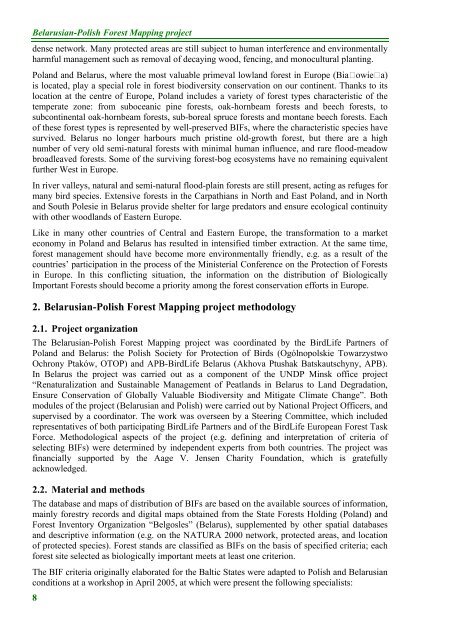Belarusian Polish Forest Mapping Belarusian Polish Forest Mapping
Belarusian Polish Forest Mapping Belarusian Polish Forest Mapping
Belarusian Polish Forest Mapping Belarusian Polish Forest Mapping
Create successful ePaper yourself
Turn your PDF publications into a flip-book with our unique Google optimized e-Paper software.
<strong>Belarusian</strong>-<strong>Polish</strong> <strong>Forest</strong> <strong>Mapping</strong> project<br />
dense network. Many protected areas are still subject to human interference and environmentally<br />
harmful management such as removal of decaying wood, fencing, and monocultural planting.<br />
Poland and Belarus, where the most valuable primeval lowland forest in Europe (Biaowiea)<br />
is located, play a special role in forest biodiversity conservation on our continent. Thanks to its<br />
location at the centre of Europe, Poland includes a variety of forest types characteristic of the<br />
temperate zone: from suboceanic pine forests, oak-hornbeam forests and beech forests, to<br />
subcontinental oak-hornbeam forests, sub-boreal spruce forests and montane beech forests. Each<br />
of these forest types is represented by well-preserved BIFs, where the characteristic species have<br />
survived. Belarus no longer harbours much pristine old-growth forest, but there are a high<br />
number of very old semi-natural forests with minimal human influence, and rare flood-meadow<br />
broadleaved forests. Some of the surviving forest-bog ecosystems have no remaining equivalent<br />
further West in Europe.<br />
In river valleys, natural and semi-natural flood-plain forests are still present, acting as refuges for<br />
many bird species. Extensive forests in the Carpathians in North and East Poland, and in North<br />
and South Polesie in Belarus provide shelter for large predators and ensure ecological continuity<br />
with other woodlands of Eastern Europe.<br />
Like in many other countries of Central and Eastern Europe, the transformation to a market<br />
economy in Poland and Belarus has resulted in intensified timber extraction. At the same time,<br />
forest management should have become more environmentally friendly, e.g. as a result of the<br />
countries’ participation in the process of the Ministerial Conference on the Protection of <strong>Forest</strong>s<br />
in Europe. In this conflicting situation, the information on the distribution of Biologically<br />
Important <strong>Forest</strong>s should become a priority among the forest conservation efforts in Europe.<br />
2. <strong>Belarusian</strong>-<strong>Polish</strong> <strong>Forest</strong> <strong>Mapping</strong> project methodology<br />
2.1. Project organization<br />
The <strong>Belarusian</strong>-<strong>Polish</strong> <strong>Forest</strong> <strong>Mapping</strong> project was coordinated by the BirdLife Partners of<br />
Poland and Belarus: the <strong>Polish</strong> Society for Protection of Birds (Ogólnopolskie Towarzystwo<br />
Ochrony Ptaków, OTOP) and APB-BirdLife Belarus (Akhova Ptushak Batskautschyny, APB).<br />
In Belarus the project was carried out as a component of the UNDP Minsk office project<br />
“Renaturalization and Sustainable Management of Peatlands in Belarus to Land Degradation,<br />
Ensure Conservation of Globally Valuable Biodiversity and Mitigate Climate Change”. Both<br />
modules of the project (<strong>Belarusian</strong> and <strong>Polish</strong>) were carried out by National Project Officers, and<br />
supervised by a coordinator. The work was overseen by a Steering Committee, which included<br />
representatives of both participating BirdLife Partners and of the BirdLife European <strong>Forest</strong> Task<br />
Force. Methodological aspects of the project (e.g. defining and interpretation of criteria of<br />
selecting BIFs) were determined by independent experts from both countries. The project was<br />
financially supported by the Aage V. Jensen Charity Foundation, which is gratefully<br />
acknowledged.<br />
2.2. Material and methods<br />
The database and maps of distribution of BIFs are based on the available sources of information,<br />
mainly forestry records and digital maps obtained from the State <strong>Forest</strong>s Holding (Poland) and<br />
<strong>Forest</strong> Inventory Organization “Belgosles” (Belarus), supplemented by other spatial databases<br />
and descriptive information (e.g. on the NATURA 2000 network, protected areas, and location<br />
of protected species). <strong>Forest</strong> stands are classified as BIFs on the basis of specified criteria; each<br />
forest site selected as biologically important meets at least one criterion.<br />
The BIF criteria originally elaborated for the Baltic States were adapted to <strong>Polish</strong> and <strong>Belarusian</strong><br />
conditions at a workshop in April 2005, at which were present the following specialists:<br />
8

















